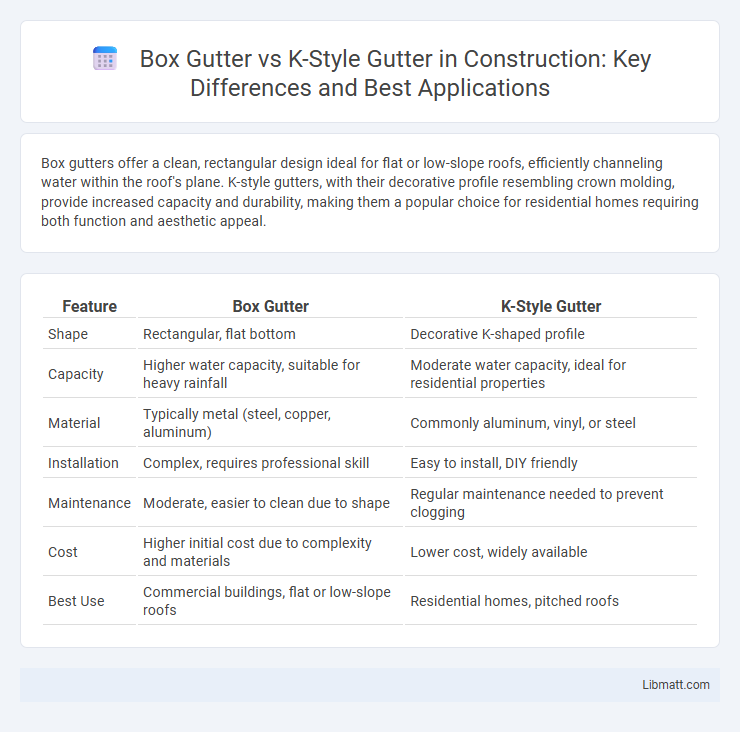Box gutters offer a clean, rectangular design ideal for flat or low-slope roofs, efficiently channeling water within the roof's plane. K-style gutters, with their decorative profile resembling crown molding, provide increased capacity and durability, making them a popular choice for residential homes requiring both function and aesthetic appeal.
Table of Comparison
| Feature | Box Gutter | K-Style Gutter |
|---|---|---|
| Shape | Rectangular, flat bottom | Decorative K-shaped profile |
| Capacity | Higher water capacity, suitable for heavy rainfall | Moderate water capacity, ideal for residential properties |
| Material | Typically metal (steel, copper, aluminum) | Commonly aluminum, vinyl, or steel |
| Installation | Complex, requires professional skill | Easy to install, DIY friendly |
| Maintenance | Moderate, easier to clean due to shape | Regular maintenance needed to prevent clogging |
| Cost | Higher initial cost due to complexity and materials | Lower cost, widely available |
| Best Use | Commercial buildings, flat or low-slope roofs | Residential homes, pitched roofs |
Introduction to Box Gutters and K-Style Gutters
Box gutters feature a rectangular cross-section designed to be integrated into the roof structure, efficiently channeling water away from flat or low-slope roofs. K-style gutters have a distinctive profile resembling the letter 'K,' providing a decorative appearance while offering high capacity for water flow, making them ideal for residential homes. Both types differ in installation and aesthetics, with box gutters suited for concealment and K-style gutters preferred for visible, effective drainage.
Key Design Differences
Box gutters feature a rectangular, box-like shape designed to fit within the roofline, providing discreet water drainage, while K-style gutters have a decorative front profile resembling the letter "K," offering enhanced capacity and improved water flow. Box gutters are often integrated into flat or low-slope roofs, requiring precise construction for effective water management, whereas K-style gutters are commonly installed on pitched roofs with exposed fascia. The key design difference lies in the shape and installation method, impacting aesthetics, capacity, and suitability for various roof types.
Material Options for Both Gutter Types
Box gutters are commonly constructed from durable materials such as galvanized steel, aluminum, copper, and zinc, offering strong resistance to corrosion and customized sizing for flat or low-slope roofs. K-style gutters are typically made from aluminum, vinyl, steel, and copper, providing lightweight options with decorative profiles to enhance aesthetic appeal. Both gutter types offer various material options tailored for climate resilience, maintenance requirements, and architectural design preferences.
Installation Process Comparison
Box gutters require precise alignment and sealing within roof valleys to ensure proper water drainage, often demanding specialized skills and more time during installation. K-style gutters feature a simpler attachment method using hangers or brackets along the fascia, allowing for quicker and more straightforward installation, often by homeowners or general contractors. The complexity of box gutter installation typically results in higher labor costs compared to the more efficient and cost-effective K-style gutter setup.
Cost Analysis: Box Gutter vs K-Style Gutter
Box gutters generally have a higher installation cost due to their complex design and need for custom fabrication, which can impact your overall budget significantly. K-style gutters are typically more cost-effective, offering easier installation and a wider range of pre-manufactured options that reduce labor expenses. When assessing your project's expenses, factoring in both initial material costs and long-term maintenance is crucial to determine the best investment between box gutters and K-style gutters.
Performance and Water Flow Efficiency
Box gutters offer superior water flow efficiency due to their larger, rectangular profile, which accommodates higher volumes of water and minimizes overflow risk during heavy rain. K-style gutters, with their decorative profile and smaller capacity, may struggle with water flow in intense storms but excel in residential settings with moderate rainfall. Performance-wise, box gutters are ideal for commercial buildings requiring robust drainage, while K-style gutters provide adequate performance with enhanced aesthetic appeal for homes.
Durability and Maintenance Requirements
Box gutters offer superior durability due to their enclosed design, which reduces debris accumulation and minimizes corrosion risk, making them ideal for heavy rain areas. K-style gutters, while more prone to clogging due to their open edge design, require more frequent cleaning to maintain optimal water flow and prevent damage. Your choice between the two should consider the balance between long-term durability and the level of routine maintenance you are prepared to undertake.
Aesthetic Impact on Home Exteriors
Box gutters offer a sleek, minimalistic appearance that blends seamlessly with your home's roofline, enhancing a modern or contemporary aesthetic. In contrast, K-style gutters feature a more pronounced profile with decorative edges that complement traditional or classic home exteriors, adding visual interest and character. Choosing between these gutter styles helps define your home's curb appeal by aligning functional drainage with your preferred architectural style.
Suitability for Different Roof Types
Box gutters are ideal for flat or low-slope roofs due to their rectangular shape and ability to handle large volumes of water efficiently. K-style gutters suit pitched or sloped roofs better, offering enhanced water flow and effective debris management with their decorative, scalloped edge. Choosing the right gutter depends on your roof's pitch and drainage needs for optimal performance.
Which Gutter Style Is Best for Your Home?
Choosing between box gutters and K-style gutters depends on your home's architecture and rainfall patterns. Box gutters offer a sleek, hidden design ideal for modern homes with low to moderate rainfall, while K-style gutters, with their larger capacity and durability, suit traditional homes facing heavy rain and debris. Your choice should balance aesthetics, maintenance, and local weather conditions to protect your home effectively.
Box gutter vs K-style gutter Infographic

 libmatt.com
libmatt.com